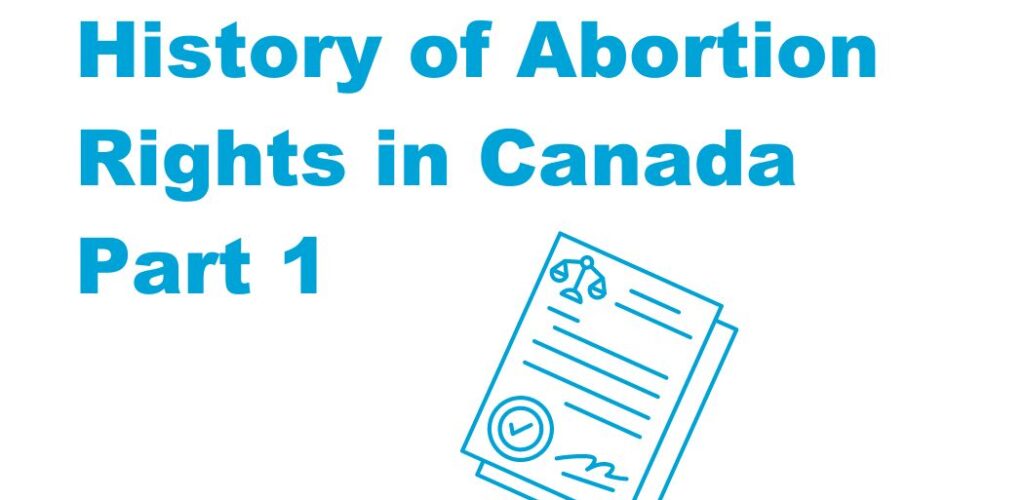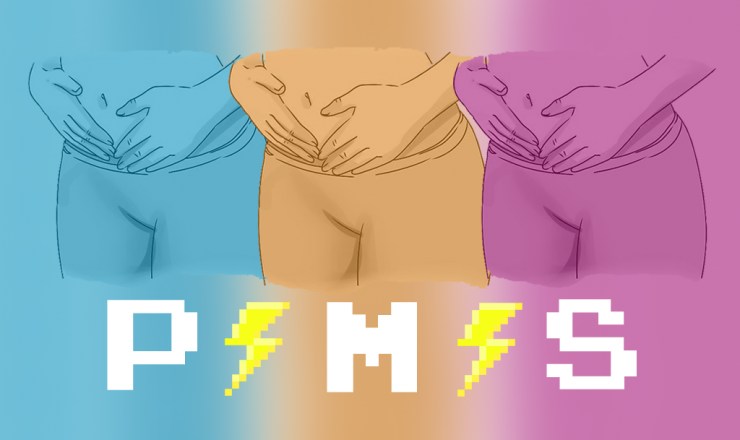

This article gives a brief background on the history of abortion rights in Canada. To learn more about what abortions are and how they work, check out our page on choosing to have an abortion!
An abortion is a medical procedure that ends a pregnancy, and they are currently legal in Canada. However, looking back on Canada’s history shows that this has not always been the case. Like many other human rights issues, progress has only been made by the work of activists and organizations pushing back against the status quo – and the fight continues! With the recent overturning of Roe v Wade and subsequent banning of abortions in the US, growing political and societal pushback against providing reproductive health care and education, and abortion access issues across Canada, we know the work isn’t over. Understanding what’s happened to get us where we are is just one part of continuing the fight against anti-abortion movements that still persist across the globe today.
Disclaimer: Many of the bills and legislation discussed in this article use the term ‘woman’ to refer to someone who can get pregnant. We use these terms only to reference the language used at the time by lawmakers and government officials, and recognize that anyone with a uterus can get pregnant, not just women.
1892 – The Banning of Abortion
Canada’s first Criminal Code was created in 1892 (the criminal code is a federal law that describes which acts are considered to be crimes). Section 251 of the 1982 Criminal Code banned both abortions and the purchasing of contraceptives (products that prevent pregnancy). The punishment for someone who provided an abortion, typically a doctor, was lifelong imprisonment. Ultimately, an abortion was a criminal offence.
1969 – Amendment of Canada’s Criminal Code
In 1969, when the federal government was led by Prime Minister Pierre Trudeau’s Liberal Party, a piece of legislation called Bill C-150 was approved by the House of Commons. Bills are suggestions for new laws and legal policies made by government officials that have to be approved by both houses of Parliament before they pass into law. Bill C-150 (also known as the Criminal Law Amendment Act, 1968-69) made a lot of important changes to Canada’s Criminal Code.
One of these changes was making abortions legal if a Therapeutic Abortion Committee (TAC) determined that pregnancy would pose harm to the pregnant person. TAC’s were made up of 3 doctors and were only available at some hospitals. If the TAC decided that pregnancy was harmful, they would issue a certificate to the pregnant person, allowing them to undergo an abortion legally. Another significant change implemented by Bill C-150 was the decriminalization of contraceptives. Decriminalizing something means getting rid of any laws that made it illegal in the first place. Both of these changes were a huge step toward achieving reproductive justice.
1970 – Royal Commission on the Status of Women in Canada
In 1970, the Royal Commission on the Status of Women was completed. Commissions are basically investigations into issues of concern, like human rights. The aim of the commission was to evaluate and reduce the amount of gender inequality in Canada. The commission culminated in a report that provided 167 recommendations to the federal government, one of which related to abortion. The report recommended that abortions should be allowed if a pregnant woman of 12 weeks or less wanted one. For pregnant women of 12 weeks or more, the report recommended that if a doctor determined there could be physical or mental harm to the pregnant woman or child if pregnancy continued, that an abortion be permitted.
1970 – The Abortion Caravan
The Abortion Caravan was a pro-abortion protest held in 1970. The protest was initiated by the Vancouver Women’s Caucus, a feminist organization established at Simon Fraser University. As these protesters made their way from Vancouver to Ottawa, they held public meetings in various cities, building support with some women’s groups and facing disapproval from anti-abortion groups.
The protest grew as it travelled across the country, and by the time it arrived in Ottawa, hundreds of protesters were taking part.Government officials including Prime Minister Pierre Trudeau refused to meet with them, leading to a protest at Prime Minister Pierre Trudeau’s home where protestors gave speeches, and left a coffin behind representing the numerous women who had died from unsafe, illegal abortions. Another protest occurred at Parliament Hill for 2 days, where they successfully shut down the House of Commons (a part of the Canadian government responsible for creating and passing bills) for the first time in history. The abortion caravan drew public attention from across the country towards abortion rights and was a critical part of the movement to legalize abortions.
1974 to Present – The Rise of Abortion Organizations
Many reproductive justice organizations were established as a result of the movement to legalize abortions. One example was the Canadian Abortion Rights Action League (CARAL), which formed in 1974. CARAL was a national abortion rights group which primarily focused on changing Canadian legislation on abortion. CARAL was also known for protesting the arrest of Dr. Henry Morgentaler, a Canadian doctor known for his abortion advocacy and provision of illegal abortions.
Other organizations were formed like the Ontario Coalition for Abortion Clinics (OCAC), which was started by healthcare workers in 1982. OCAC requested the Ontario government support clinics that would provide abortion services, and fought against anti-abortion laws. OCAC established an illegal abortion clinic in Toronto that stayed open despite raids from police and arrests of its doctors.
1967 to 2006 – Dr. Henry Morgentaler
Dr. Henry Morgentaler was a Canadian doctor and abortion rights activist. The beginning of his role in abortion rights can be traced back to 1967. At a meeting with the House of Commons Health and Welfare Committee, Morgentaler stated that women should be able to get an abortion if they simply wanted to and that the legislation making abortions illegal should be removed. When this public statement caused many women to seek abortions from Morgentaler, he initially refused due to the negative repercussions that could occur. Eventually he changed his mind and started to perform illegal abortions.
Morgentaler created his first abortion clinic in Montreal in 1969. Over the subsequent years, he was arrested multiple times for providing illegal abortions, and was once sentenced to 8 months of imprisonment. In 1973, he publicly stated that he had performed over 5000 safe abortions in order to bring attention to the issue, which led to another arrest. He continued to open more illegal abortion clinics, many of which faced a lot of backlash like police raids, protests, vandalism, and violence like the 1992 firebombing of his Toronto abortion clinic. In addition to his many arrests and imprisonment, Morgentaler faced other consequences for his abortion advocacy, including threats to his life and suspension of his medical licence.
1988 – The Legalization of Abortion
The first time Morgentaler legally challenged anti-abortion legislation was in 1976. Through his case Morgentaler v. The Queen, he strived to repeal the legislation that banned abortions. He supported his case by stating that the methods used for abortions no longer posed harm to a pregnant woman’s health. He also stated that the banning of abortions violated the Bill of Rights, a federal law that protects various human rights. Morgentaler ultimately lost this case, as the Supreme Court ruled that anti-abortion laws were still necessary.
Morgentaler attempted another legal challenge 12 years later in 1988, through his case, R. v. Morgentaler. This time Morgentaler was successful, as the Supreme Court ruled that making abortion a criminal act is unconstitutional. This was due to their decision that the criminalization of abortions violated section 7 of the Charter of Rights and Freedoms, specifically the right to “life, liberty and security of person.” Similar to the 1973 case of Roe v Wade in the US, R. v. Morgentaler was the landmark case that legalized abortion in Canada.
1989 – Tremblay v Daigle
Another important legal case regarding abortions in Canada took place in 1989. This case involved a woman, who at the time of separating from her partner was pregnant and wanted an abortion. At the time, the Quebec Court of Appeal ruled that a fetus had legal rights, and her former partner used this via a court order to try and stop her. She appealed by going to the Supreme Court of Canada with the Supreme Court ruling that a fetus does not have legal status, so the partner of a pregnant woman cannot prevent them from getting an abortion on its behalf.
1990 – Bill C-43
Bill C-43 was a bill that proposed an amendment to Canada’s Criminal Code attempting to ban abortions once again by making it illegal to have one unless the pregnancy threatened the woman’s health. The creation of this bill sparked many protests by pro-choice activists. In order for a bill to be made into a law, it needs to be passed by the House of Commons and the Senate. Bill C-43 was passed by the House of Commons in 1990, but was then overturned by the Senate in 1991, meaning it was not approved to be made into a law.
Resources
If you have questions about this topic, feel free to contact one of our peer educators. [Link]
Last updated: January 2023.

OHIP+ helps cover medication costs for youth 24 and under who don’t have private insurance. This post answers some of our OHIP+ FAQs.

In this FAQ we’re covering some questions about Pre-Menstrual Syndrome, how to cope with PMS symptoms, and how to talk to partners about it.

Cheating can be hard on a relationship. It’s normal for partners who have been cheated on to feel angry or lost. This post covers some things partners can consider when dealing with the complicated emotions or tough decisions that can come up in the aftermath.